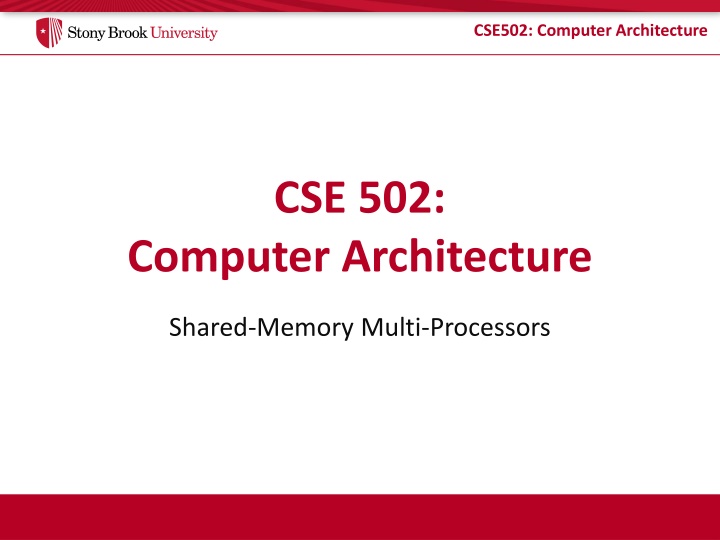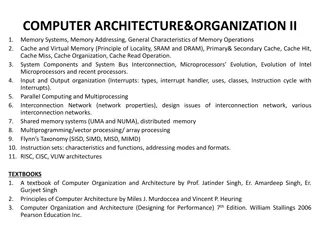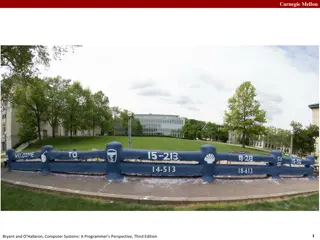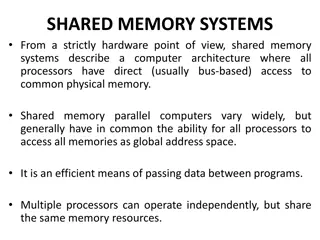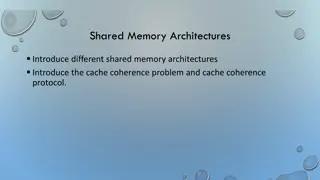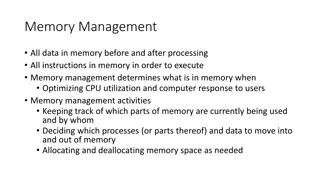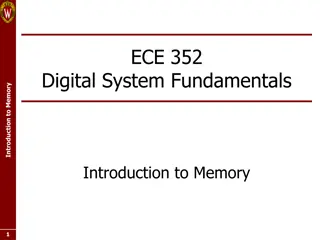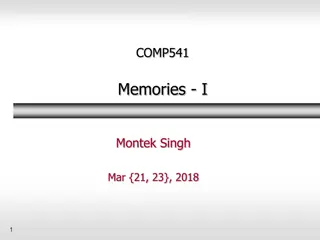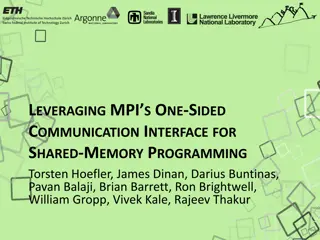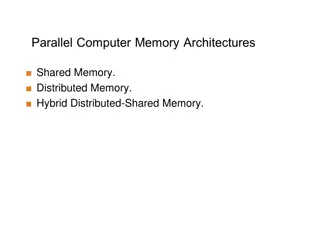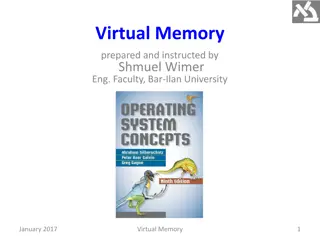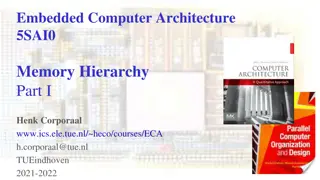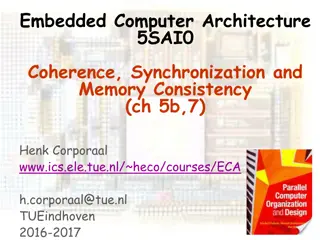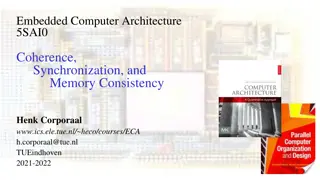Computer Architecture: Shared Memory Systems
Shared memory multiprocessors in computer architecture involve multiple threads using shared memory for communication, with synchronization complexities and implicit communication challenges. Despite these drawbacks, Shared Memory Systems have proven to be successful machines due to their evolutionary extensions and multi-billion-dollar markets. Paired versus separate processor/memory configurations and shared versus point-to-point networks provide insights into memory access and network scalability implications.
Download Presentation

Please find below an Image/Link to download the presentation.
The content on the website is provided AS IS for your information and personal use only. It may not be sold, licensed, or shared on other websites without obtaining consent from the author.If you encounter any issues during the download, it is possible that the publisher has removed the file from their server.
You are allowed to download the files provided on this website for personal or commercial use, subject to the condition that they are used lawfully. All files are the property of their respective owners.
The content on the website is provided AS IS for your information and personal use only. It may not be sold, licensed, or shared on other websites without obtaining consent from the author.
E N D
Presentation Transcript
CSE502: Computer Architecture CSE 502: Computer Architecture Shared-Memory Multi-Processors
CSE502: Computer Architecture Shared-Memory Multiprocessors Multiple threads use shared memory (address space) SysV Shared Memory or Threads in software Communication implicit via loads and stores Opposite of explicit message-passing multiprocessors Theoretical foundation: PRAM model P1 P2 P3 P4 Memory System
CSE502: Computer Architecture Why Shared Memory? Pluses App sees multitasking uniprocessor OS needs only evolutionary extensions Communication happens without OS Minuses Synchronization is complex Communication is implicit (hard to optimize) Hard to implement (in hardware) Result SMPs and CMPs are most successful machines to date First with multi-billion-dollar markets
CSE502: Computer Architecture Paired vs. Separate Processor/Memory? Separate CPU/memory Uniform memory access (UMA) Equal latency to memory Low peak performance Paired CPU/memory Non-uniform memory access (NUMA) Faster local memory Data placement matters High peak performance CPU($) CPU($) CPU($) CPU($) CPU($) Mem CPU($) Mem CPU($) Mem CPU($) Mem R R R R Mem Mem Mem Mem
CSE502: Computer Architecture Shared vs. Point-to-Point Networks Shared network Example: bus Low latency Low bandwidth Doesn t scale >~16 cores Simple cache coherence Point-to-point network: Example: mesh, ring High latency (many hops ) Higher bandwidth Scales to 1000s of cores Complex cache coherence CPU($) Mem CPU($) Mem CPU($) Mem CPU($) Mem R CPU($) Mem R CPU($) Mem R R R R Mem R R Mem CPU($) CPU($)
CSE502: Computer Architecture Organizing Point-To-Point Networks Network topology: organization of network Trade off perf. (connectivity, latency, bandwidth) cost Router chips Networks w/separate router chips are indirect Networks w/ processor/memory/router in chip are direct Fewer components, Glueless MP R CPU($) Mem R CPU($) Mem R R R Mem R Mem R Mem R Mem R Mem R R Mem CPU($) CPU($) CPU($) CPU($) CPU($) CPU($)
CSE502: Computer Architecture Issues for Shared Memory Systems Two big ones Cache coherence Memory consistency model Closely related Often confused
CSE502: Computer Architecture Cache Coherence: The Problem (1/2) Variable A initially has value 0 P1 stores value 1 into A P2 loads A from memory and sees old value 0 P1 P2 t1: Store A=1 t2: Load A? A: 0 A: 0 1 A: 0 L1 L1 Bus A: 0 Main Memory Need to do something to keep P2 s cache coherent
CSE502: Computer Architecture Cache Coherence: The Problem (2/2) P1 and P2 have variable A (value 0) in their caches P1 stores value 1 into A P2 loads A from its cache and sees old value 0 P1 P2 t1: Store A=1 t2: Load A? A: 0 A: 0 1 A: 0 L1 L1 Bus A: 0 Main Memory Need to do something to keep P2 s cache coherent
CSE502: Computer Architecture Approaches to Cache Coherence Software-based solutions Mechanisms: Mark cache blocks/memory pages as cacheable/non-cacheable Add Flush and Invalidate instructions Could be done by compiler or run-time system Difficult to get perfect (e.g., what about memory aliasing?) Hardware solutions are far more common System ensures everyone always sees the latest value
CSE502: Computer Architecture Coherence with Write-through Caches Allows multiple readers, but writes through to bus Requires Write-through, no-write-allocate cache All caches must monitor (aka snoop ) all bus traffic Simple state machine for each cache frame P1 P2 t1: Store A=1 A [V]: 0 A [V]: 0 1 A [V]: 0 A [V I]: 0 Write-through No-write-allocate t3: Invalidate A Bus t2: BusWr A=1 A: 0 A: 0 1 Main Memory
CSE502: Computer Architecture Valid-Invalid Snooping Protocol Processor Actions Ld, St, BusRd, BusWr Bus Messages BusRd, BusWr Track 1 bit per cache frame Valid/Invalid Load / BusRd Load / -- Store / BusWr Valid BusWr / -- Invalid Store / BusWr
CSE502: Computer Architecture Supporting Write-Back Caches Write-back caches are good Drastically reduce bus write bandwidth Add notion of ownership to Valid-Invalid When owner has only replica of a cache block Update it freely Multiple readers are ok Not allowed to write without gaining ownership On a read, system must check if there is an owner If yes, take away ownership
CSE502: Computer Architecture Modified-Shared-Invalid (MSI) States Processor Actions Load, Store, Evict Bus Messages BusRd, BusRdX, BusInv, BusWB, BusReply (Here for simplicity, some messages can be combined) Track 3 states per cache frame Invalid: cache does not have a copy Shared: cache has a read-only copy; clean Clean: memory (or later caches) is up to date Modified: cache has the only valid copy; writable; dirty Dirty: memory (or later caches) is out of date
CSE502: Computer Architecture Simple MSI Protocol (1/9) Load / BusRd Invalid Shared 1: Load A P1 P2 A [I S]: 0 A [I] A [I] 2: BusRd A Bus A: 0 3: BusReply A
CSE502: Computer Architecture Simple MSI Protocol (2/9) Load / BusRd BusRd / [BusReply] Load / -- Invalid Shared 1: Load A 1: Load A P1 P2 A [S]: 0 A [I S]: 0 A [I] 2: BusRd A 3: BusReply A Bus A: 0
CSE502: Computer Architecture Simple MSI Protocol (3/9) Load / BusRd BusRd / [BusReply] Load / -- Invalid Shared Evict / -- Evict A P1 P2 A [I] A [S]: 0 A [S I] A [S]: 0 Bus A: 0
CSE502: Computer Architecture Simple MSI Protocol (4/9) Load / BusRd BusRd / [BusReply] Load / -- Invalid Shared BusRdX / [BusReply] Evict / -- Store / BusRdX 1: Store A P1 P2 A [S]: 0 A [S I]: 0 A [I M]: 0 1 A [I] 2: BusRdX A 3: BusReply A Modified Bus A: 0 Load, Store / --
CSE502: Computer Architecture Simple MSI Protocol (5/9) Load / BusRd BusRd / [BusReply] Load / -- Invalid Shared BusRdX / [BusReply] Evict / -- Store / BusRdX 1: Load A P1 P2 A [I S]: 1 A [I] A [M]: 1 A [M S]: 1 3: BusReply A 2: BusRd A Modified Bus A: 0 A: 0 1 4: Snarf A Load, Store / --
CSE502: Computer Architecture Simple MSI Protocol (6/9) Load / BusRd BusRd / [BusReply] Load / -- Invalid Shared BusRdX / [BusReply] BusRdX, BusInv / [BusReply] Evict / -- Store / BusRdX 1: Store A aka Upgrade P1 P2 A [S]: 1 A [S M]: 2 A [S]: 1 A [S I] 2: BusInv A Modified Bus A: 1 Load, Store / --
CSE502: Computer Architecture Simple MSI Protocol (7/9) Load / BusRd BusRd / [BusReply] Load / -- Invalid Shared BusRdX, BusInv / [BusReply] Evict / -- BusRdX / BusReply Store / BusRdX 1: Store A P1 P2 A [M]: 2 A [M I]: 2 A [I M]: 3 A [I] 2: BusRdX A 3: BusReply A Modified Bus A: 1 Load, Store / --
CSE502: Computer Architecture Simple MSI Protocol (8/9) Load / BusRd BusRd / [BusReply] Load / -- Invalid Shared BusRdX, BusInv / [BusReply] Evict / -- BusRdX / BusReply Store / BusRdX Evict / BusWB 1: Evict A P1 P2 A [I] A [M]: 3 A [M I]: 3 2: BusWB A Modified Bus A: 1 A: 1 3 Load, Store / --
CSE502: Computer Architecture Simple MSI Protocol (9/9) Load / BusRd BusRd / [BusReply] Load / -- Invalid Shared BusRdX, BusInv / [BusReply] Evict / -- BusRdX / BusReply Store / BusRdX Evict / BusWB Cache Actions: Load, Store, Evict Bus Actions: BusRd, BusRdX BusInv, BusWB, BusReply Modified Load, Store / -- Usable coherence protocol
CSE502: Computer Architecture Scalable Cache Coherence Part I: bus bandwidth Replace non-scalable bandwidth substrate (bus) with scalable-bandwidth one (e.g., mesh) Part II: processor snooping bandwidth Most snoops result in no action Replace non-scalable broadcast protocol (spam everyone) with scalable directory protocol (spam cores that care) Requires a directory to keep track of sharers
CSE502: Computer Architecture Directory Coherence Protocols Extend memory to track caching information For each physical cache line, a home directory tracks: Owner: core that has a dirty copy (i.e., M state) Sharers: cores that have clean copies (i.e., S state) Cores send coherence events to home directory Home directory only sends events to cores that care
CSE502: Computer Architecture Read Transaction L has a cache miss on a load instruction 1: Read Req L H 2: Read Reply
CSE502: Computer Architecture 4-hop Read Transaction L has a cache miss on a load instruction Block was previously in modified state at R State: M Owner: R 1: Read Req 2: Recall Req L H R 4: Read Reply 3: Recall Reply
CSE502: Computer Architecture 3-hop Read Transaction L has a cache miss on a load instruction Block was previously in modified state at R State: M Owner: R 1: Read Req 2: Fwd d Read Req L H R 3: Fwd d Read Ack 3: Read Reply
CSE502: Computer Architecture An Example Race: Writeback & Read L has dirty copy, wants to write back to H R concurrently sends a read to H Race! Race ! State: M Owner: L No need to Ack Final State: S WB & Fwd Rd No need to ack 1: WB Req 2: Read Req 6: L H R 4: 3: Fwd d Read Req 5: Read Reply Races require complex intermediate states
CSE502: Computer Architecture Basic Operation: Read #1 Directory #2 Read A (miss) A: Shared, #1 Typical way to reason about directories
CSE502: Computer Architecture Basic Operation: Write #1 Directory #2 Read A (miss) A: Shared, #1 A: Mod., #2
CSE502: Computer Architecture Coherence vs. Consistency Coherence concerns only one memory location Consistency concerns ordering for all locations A Memory System is Coherent if Can serialize all operations to that location Operations performed by any core appear in program order Read returns value written by last store to that location A Memory System is Consistent if It follows the rules of its Memory Model Operations on memory locations appear in some defined order
CSE502: Computer Architecture Why Coherence != Consistency /* initial A = B = flag = 0 */ P1 P2 A = 1; while (flag == 0); /* spin */ B = 1; print A; flag = 1; print B; Intuition says we see 1 printed twice (A,B) Coherence doesn t say anything Different memory locations Uniprocessor ordering (LSQ) won t help Consistency defines what is correct behavior
CSE502: Computer Architecture Sequential Consistency (SC) processors issue memory ops in program order P3 P1 P2 switch randomly set after each memory op Memory Defines Single Sequential Order Among All Ops.
CSE502: Computer Architecture Sufficient Conditions for SC A multiprocessor is sequentially consistent if the result of any execution is the same as if the operations of all the processors were executed in some sequential order, and the operations of each individual processor appear in this sequence in the order specified by its program. Every proc. issues memory ops in program order Memory ops happen (start and end) atomically On Store, wait to commit before issuing next memory op On Load, wait to write back before issuing next op -Lamport, 1979 Easy to reason about, very slow (without ugly tricks)
CSE502: Computer Architecture Mutual Exclusion Example Mutually exclusive access to a critical region Works as advertised under Sequential Consistency Fails if P1 and P2 see different Load/Store order OoO allows P1 to read B before writing (committing) A P1 lockA: A = 1; if (B != 0) { A = 0; goto lockA; } /* critical section*/ A = 0; P2 lockB: B=1; if (A != 0) { B = 0; goto lockB; } /* critical section*/ B = 0;
CSE502: Computer Architecture Problems with SC Memory Model Difficult to implement efficiently in hardware Straight-forward implementations: No concurrency among memory access Strict ordering of memory accesses at each node Essentially precludes out-of-order CPUs Unnecessarily restrictive Most parallel programs won t notice out-of-order accesses Conflicts with latency hiding techniques
CSE502: Computer Architecture Mutex Example w/ Store Buffer P2 P1 Read B t1 Read A t2 Write B t3 t4 Write A Shared Bus A: 0 B: 0 P1 lockA: A = 1; if (B != 0) { A = 0; goto lockA; } /* critical section*/ A = 0; P2 lockB: B=1; if (A != 0) { B = 0; goto lockB; } /* critical section*/ B = 0; Does not work
CSE502: Computer Architecture Relaxed Consistency Models Sequential Consistency (SC): R W, R R, W R, W W Total Store Ordering(TSO) relaxes W R R W, R R, W W Partial Store Orderingrelaxes W W (coalescing WB) R W, R R Weak Ordering or Release Consistency (RC) All ordering explicitly declared Use fences to define boundaries Use acquire and release to force flushing of values X Y X must complete before Y
CSE502: Computer Architecture Atomic Operations & Synchronization Atomic operations perform multiple actions together Each of these can implement the others Compare-and-Swap (CAS) Compare memory value to arg1, write arg2 on match Test-and-Set Overwrite memory value with arg1 and return old value Fetch-and-Increment Increment value in memory and return the old value Load-Linked/Store-Conditional (LL/SC) Two operations, but Store succeeds iff value unchanged
